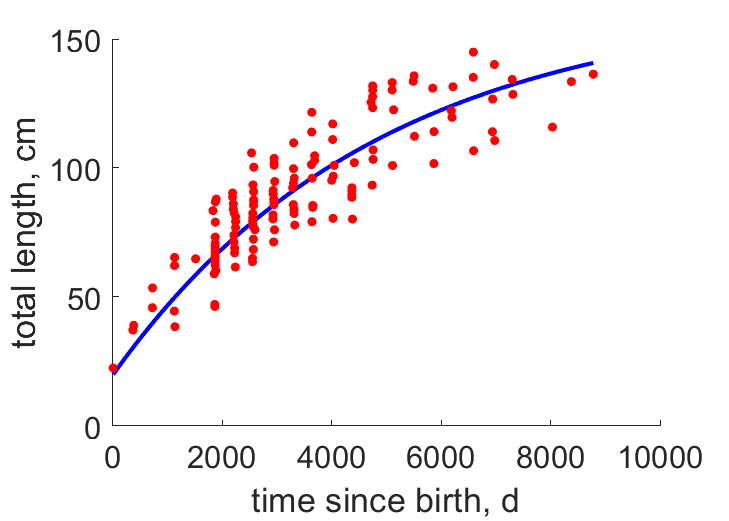Predictions & Data for this entry
| Model: std | climate: MB | migrate: Mo | phylum: |
| COMPLETE = 2.5 | ecozone: MPE | food: biCi, biCvf, biSvm | class: |
| MRE = 0.038 | habitat: 0iMpe | gender: D | order: |
| SMSE = 0.005 | embryo: Mv | reprod: O | family: |
Zero-variate data
| Data | Observed | Predicted | (RE) | Unit | Description | Reference |
|---|---|---|---|---|---|---|
| ab | 365 | 441.4 | (0.2094) | d | age at birth | ADW |
| am | 1.095e+04 | 1.095e+04 | (6.955e-05) | d | life span | fishbase |
| Lb | 20 | 19.72 | (0.01397) | cm | total length at birth | Wiki |
| Lp | 110 | 112.3 | (0.0211) | cm | total length at puberty for females | KushSmit1992 |
| Lpm | 100 | 101.8 | (0.01842) | cm | total length at puberty for males | KushSmit1992 |
| Li | 160 | 164.3 | (0.02676) | cm | ultimate total length for females | KushSmit1992 |
| Wwb | 28.3 | 27.71 | (0.02076) | g | wet weight at birth | fishbase |
| Wwp | 5130 | 5120 | (0.001887) | g | wet weight at puberty for females | fishbase |
| Wwpm | 3840 | 3817 | (0.006055) | g | wet weight at puberty for males | fishbase |
| Wwi | 1.61e+04 | 1.602e+04 | (0.004911) | g | ultimate wet weight | fishbase |
| Ri | 0.07945 | 0.08041 | (0.01203) | #/d | maximum reprod rate | fishbase |
Uni- and bivariate data
| Data | Figure | Independent variable | Dependent variable | (RE) | Reference |
|---|---|---|---|---|---|
| tL |  | time since birth | total length | (0.1095) | KushSmit1992 |
Pseudo-data at Tref = 20°C
| Data | Generalised animal | Triakis semifasciata | Unit | Description |
|---|---|---|---|---|
| v | 0.02 | 0.02854 | cm/d | energy conductance |
| kap | 0.8 | 0.6483 | - | allocation fraction to soma |
| kap_R | 0.95 | 0.95 | - | reproduction efficiency |
| p_M | 18 | 20.76 | J/d.cm^3 | vol-spec som maint |
| k_J | 0.002 | 0.002 | 1/d | maturity maint rate coefficient |
| kap_G | 0.8 | 0.8011 | - | growth efficiency |
Discussion
- Males are assumed to differ from females by E_Hp only
- Relatively poor fit might be due to cannibalism among neonates in mother's belly, meaning that kap is too low
Facts
- Ovoviparity (aplacental viviparity) (Ref: fishbase)
- Preferred temp 12.4 C, usually 0 - 156 m deep (Ref: fishbase)
- Ww (in g) = 0.00305*(TL in cm)^3.05 (Ref: fishbase)
Bibliography